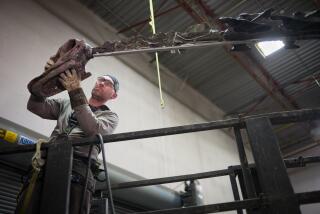‘Dinosaur Eggs’ Ready to Hatch
- Share via
Luis Chiappe has a hard time putting into words the enormous excitement he felt in 1997 when he played a major role in discovering a chunk of embryonic skin inside a dinosaur egg.
Chiappe, the associate curator and chairman of the department of vertebrae paleontology at the Natural History Museum of Los Angeles County, was leading a field expedition in Patagonia, Argentina, when he and his team of dinosaur sleuths became the first crew to unearth such a fossilized specimen. Simply finding a dinosaur embryo is a rarity.
“It was such a profound and rewarding moment,” the Argentine native said during a recent interview at his office at the Natural History Museum. “I’ve done fieldwork in many places [particularly in Patagonia]. To be the first people to ever look at embryonic dinosaur skin . . . I would say [it was the highlight of my career].”
Beginning Saturday, Natural History Museum visitors will also have the opportunity to see numerous fossilized dinosaur eggs, embryos and embryonic skin discovered during this ongoing expedition. The exhibit is called “Tiniest Giants: Discovering Dinosaur Eggs.”
While these uncommon items are on loan from Argentina’s Carmen Funes Museum, the 6,000-square-foot presentation was designed by Chiappe and the Natural History Museum. After the exhibit’s Los Angeles run ends on Oct. 8, it will tour various museums across the country. Eventually, these specimens will go on permanent display in Argentina.
This prehistoric discovery was stunning in more ways than one. The eggs Chiappe and his team encountered in Patagonia represent, by far, the largest dinosaur nesting site ever discovered. Chiappe estimates that there are thousands of egg clutches that stretch at least five miles in an inhospitable region in the northwest corner of Patagonia, which is about 600 miles southwest of Buenos Aires. The clutches of eggs contain about 15 to 40 eggs each. Many of them are set five to 10 feet apart.
The embryonic evidence indicates that four-footed, long-necked dinosaurs called titanosaurs were behind this nesting site. Chiappe says footprint evidence had suggested that these plant-eating dinosaurs might have traveled in herds of perhaps 40 or 50. But this massive nesting site shows that many more of these creatures converged to lay their eggs.
“Undoubtedly they gathered in large numbers,” Chiappe observes. “Hundreds? Perhaps. Thousands? Perhaps. It’s hard to say. But it’s inconceivable that the hundreds of thousands of eggs [we found] were laid by solitary females.”
Chiappe and his team also discovered four layers of eggs fossilized in mud, which suggests that these titanosaurs returned numerous times to nest at this site. He believes floods caused the fossilization of these clutches in this semiarid region.
The Stories That Surround Discovery
“Tiniest Giants” isn’t just designed to showcase these dinosaur eggs and embryos and what they tell us about dinosaur reproduction. With this ambitious exhibit, the Natural History Museum also aims to illustrate the processes and experiences involved in bringing these valuable specimens to public view.
“People think that you discover something and that’s it,” he says. “But in paleontology, the discovery is just the beginning. It unfolds over a decade or so of careful investigation. You return and return to the scene of the crime like detectives. You keep working and you find more every time you return.”
Chiappe and his crew return for a month every year to continue work at the Patagonia site.
The exhibit’s various dioramas will play an important role in demonstrating how dinosaur fossils are discovered, unearthed, charted, examined and prepared. Visitors will see how a dinosaur expedition is planned and then what ensues once various members of a team--which includes paleontologists, geologists, technicians, students and volunteers--reach the excavation site.
Dioramas will show team members collecting eggs and logging data in an environment depicting the rugged terrain of Patagonia. Another tableau will show what happens when specimens are brought back to a laboratory for further examination and preparation.
“We tell visitors how we know that the eggs were laid about 80 million years ago,” explains Chiappe. “We have a whole geology wall in which you see aspects of how to date fossils.”
Another part of the exhibit portrays baby titanosaur models hatching from their nests. These new hatchlings were no bigger than a human baby. But by the time they were 20 years old, these dinosaurs were bigger than a school bus. A 5-foot-long tennis shoe is on display to illustrate what size shoe an average-sized adult human might wear if he or she experienced a similar growth rate.
Presented in English and Spanish, “Tiniest Giants” also employs video presentations and various written and interactive displays.
The Natural History Museum’s last temporary dinosaur exhibit was “A T. rex Named Sue,” which closed last month. It was a particularly appealing attraction because it represented a replica of the largest, best-preserved and most complete Tyrannosaurus rex skeleton ever found. Chiappe feels “Tiniest Giants” can be just as appealing.
“The idea of baby dinosaurs is something that has great appeal to people,” he says. “For me, it’s important because this project has offered great insight into the issue of dinosaur reproduction and development.”
*
* “Tiniest Giants: Discovering Dinosaur Eggs,” Natural History Museum of Los Angeles County, 900 Exposition Blvd., Exposition Park, Los Angeles. This Saturday through Oct. 8. Museum hours: Saturday-Sunday, 10 a.m.-5 p.m.; weekdays, 9:30 a.m.-5 p.m. $8; students with ID and over age 62, $5.50; ages 5-12, $2; under age 5, free. (213) 763-DINO or https://www.nhm.org.
More to Read
Sign up for Essential California
The most important California stories and recommendations in your inbox every morning.
You may occasionally receive promotional content from the Los Angeles Times.













